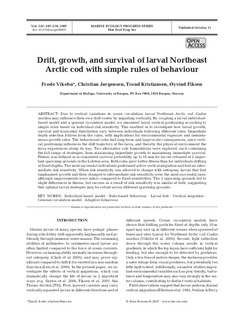| dc.description.abstract | Due to vertical variations in ocean circulation, larval Northeast Arctic cod Gadus morhua may influence their own drift routes by migrating vertically. By coupling a larval individual-based model and a general circulation model, we simulated larval vertical positioning according to simple rules based on individual risk sensitivity. This enabled us to investigate how larval growth, survival and horizontal distribution vary between individuals following different rules. Immediate depth selection follows from the rules, with implications for environmental exposure and instantaneous growth rates. The behavioural rules had long-term and large-scale consequences, since vertical positioning influences the drift trajectory of the larva, and thereby the physical environment the larva experiences along its way. Two alternative rule formulations were explored, each containing the full range of strategies, from maximising immediate growth to maximising immediate survival. Fitness was defined as accumulated survival probability up to 18 mm for larvae released at 2 important spawning grounds in the Lofoten area. Both rules gave better fitness than for individuals drifting at fixed depths. The most successful individuals performed active vertical migration and had an intermediate risk sensitivity. When risk sensitivity was allowed to change with ontogeny, larvae that first emphasised growth and then changed to intermediate risk sensitivity were the most successful ones, although improvements were minor compared to fixed sensitivities. The 2 spawning grounds led to slight differences in fitness, but success as a result of risk sensitivity was similar at both, suggesting that optimal larval strategies may be robust across different spawning grounds. | no_NO |
